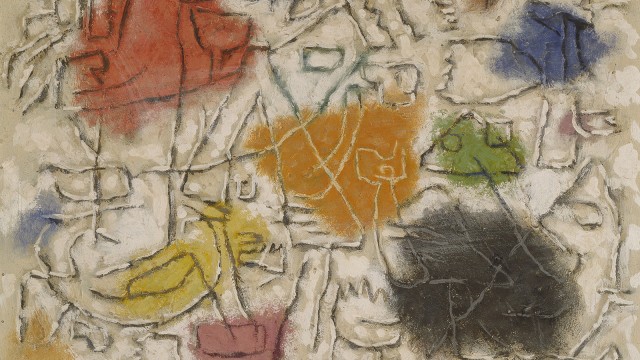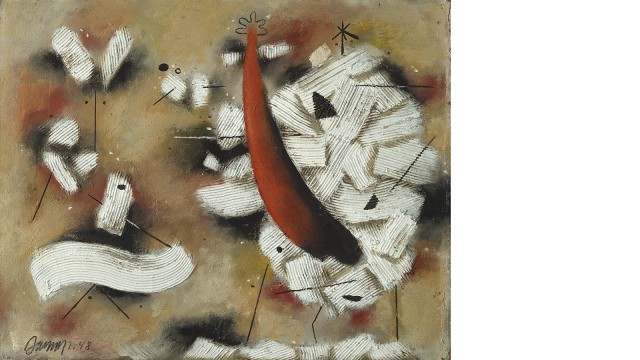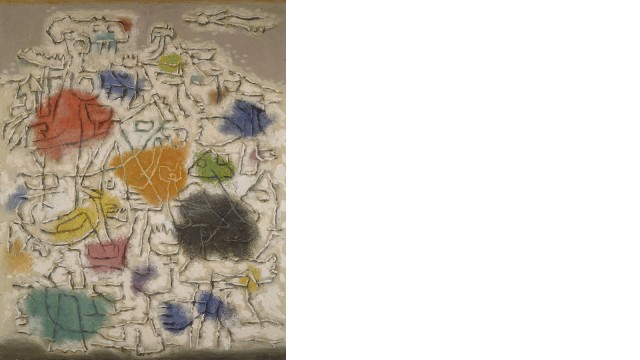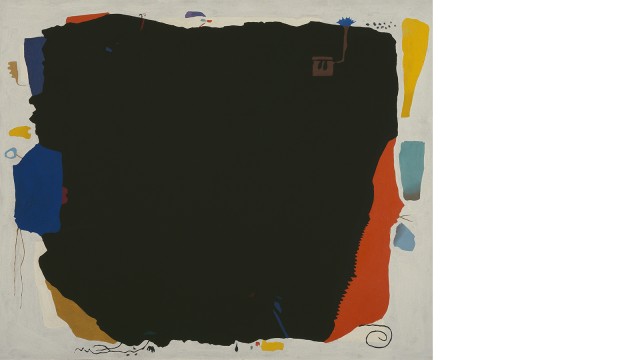
Works in the Collection
The diverse output of Willi Baumeister first started in Adolf Hölzel’s composition class at the academy in Stuttgart. Here, in 1909, he met Oskar Schlemmer and Otto Meyer-Amden, whose art shared Baumeister’s focus on the surface tectonics of the human figure, inspired by their tutor. Until around 1930, Baumeister’s works were characterized by reduced-scale anthropomorphic and basic geometric shapes, which also featured in numerous set designs that Baumeister produced from 1919. His reflections on an abstract expression in art that follows an autonomy in the free use of shapes and colors rather than aiming for naturalistic, representational images initially led to the pioneering set of “Mauerbilder” around 1919. With these works, Baumeister laid the foundations for his subsequent evolution as an artist, as he regarded the surface as the “primordial means, the first elementary medium of painting”. In the “Mauerbilder”, the surface of the picture plane is created in relief, and he would treat surfaces in an identical or similar way in subsequent groups of works.

From 1928, around the same time as his appointment at the Kunstgewerbeschule in Frankfurt, Willi Baumeister’s work became influenced by his interest in objects and artifacts from Africa and Oceania, fossils, prehistoric and protohistoric stone tools, and his study of the pictorial creations of Stone-Age rock and cave paintings. Although Baumeister was stripped of his professorship in Frankfurt when the Nazis came to power in 1933, and had an exhibition ban imposed on him in 1941, he still continued to develop his artistic approaches to composition. He produced groups of works including his “Ideogramme” and “Kammzuglandschaften”. In 1943, Baumeister also started writing a manuscript in which he summed up his theoretical thinking. It was published under the title “Das Unbekannte in der Kunst” (The Unknown in Art) in 1947, one year after his appointment at the Stuttgart art academy.

Two of Baumeister paintings in the LBBW Collection, “Weißer Kammzug” and “Belebte Halde II”, are revealing examples of how the artist approached the vivid structuring of surfaces. Aside from the free-floating shapes, touches of color and pictorial signs, the white oil-based paint is given a succinct internal structure with either a metal comb, or by using synthetic resin and filler emphasizing the impression of carved lines. Both of these works also reflect Baumeister’s aesthetic belief that abstract art should be understood as a metaphor parallel to nature.
Like his earlier works, Willi Baumeister’s late groups of works entitled “Han-i”, “Montaru”, and “ARU” hover between motif and absence of motif with their image content. By this stage, the subject matter of his paintings was mainly a multitude of corresponding masses of color, which were dominated by a large black color field in “Montaru 7A”. Baumeister managed to achieve substantial clarity in creating a colored shape as shaped matter, an approach which he had already followed in his “Ideogramme” and “Eidos” paintings.
Since 2005, the "Willi Baumeister Archive” has been housed at the Kunstmuseum Stuttgart. The archive contains autographs, photos, publications by and about Willi Baumeister, and audio and video recordings.

Biography
Willi Baumeister (1889–1955): Born in Stuttgart. Trains as a decorative painter, from 1905 also studies art at the Königliche Akademie der bildenden Künste in Stuttgart, 1907 Apprentice exam as a decorative painter. Continues to study art in Adolf Hölzel’s composition class, meets Oskar Schlemmer, Ida Kerkovius, and Johannes Itten. 1911 First trip to Paris. 1913 Features in the “Erster Deutscher Herbstsalon” at the Berlin gallery “Der Sturm”. 1914 Commissioned to produce murals for the “Kölner Werkbundausstellung”, along with Schlemmer and Hermann Stenner. 1914 to 1918 Military service. 1919 Artist group “Üecht” established, member until 1921. 1922 Completes his art studies and opens his own studio in Stuttgart. From 1922 Exhibitions in Germany and abroad. 1928 Appointed as Professor of commercial art, typography, and textile printing at the Frankfurter Kunstgewerbeschule (now the Städelschule art school). Member of the artist groups “Cercle et Carré” and “Abstraction – Création”. 1930 Württemberg State Prize. 1933 Dismissed from the teaching profession, banned from painting and exhibiting from 1941. 1946 Appointed as professor of decorative painting at the Staatliche Akademie der Bildenden Künste Stuttgart, 1947 Publication of “Das Unbekannte in der Kunst” (The Unknown in Art). 1949 Founding member of the artist group “ZEN 49” (original name: “Gegenstandslose”) with Rupprecht Geiger, Fritz Winter, Rolf Cavael, Gerhard Fietz and others, first group exhibition at the Central Collecting Point, Munich. 1951–1953 Deputy Rector of the Stuttgart art academy, retires in 1955. From 1949 until his death in 1955: National and international exhibitions, including at the Venice Biennale, the São Paulo Art Biennial, and the Guggenheim Museum in New York.
